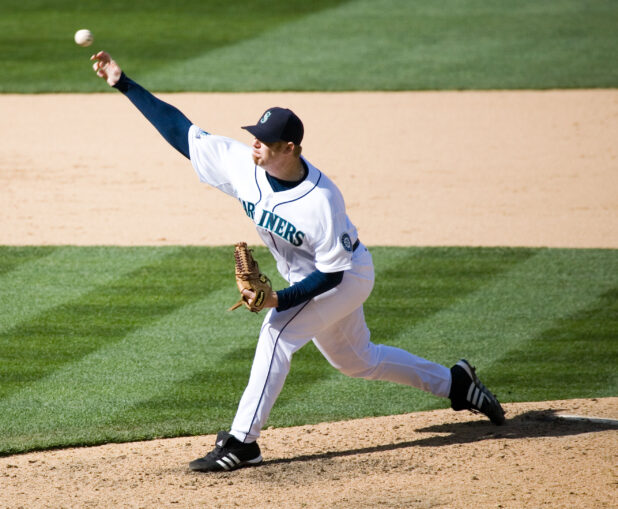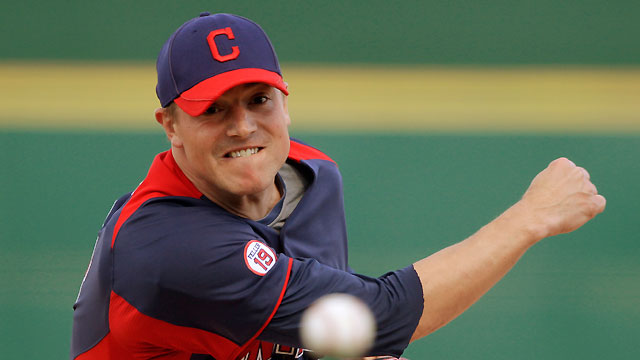
J.J. Putz had a solid 12-year MLB career as a right-handed relief pitcher. Like most relievers he experienced up-and-down years, but when he was at his peak in 2007, he was one of the best relievers in baseball.
The Seattle Mariners, Chicago White Sox and Arizona Diamondbacks all received some production from the Trenton, MI native, but the New York Mets received arguably his worst season and paid a price for their mistake.
Putz’s Rise In The Evergreen State
Putz was drafted three times before signing on with a major league organization. He was drafted by the White Sox in the third round of the 1995 MLB Draft, by the Minnesota Twins in the 17th round of the 1998 MLB Draft and by the Mariners in the sixth round of the 1999 MLB Draft.
For Putz, age was a factor in not signing with the White Sox in 1995.
“The ’95 one was kind of easy: I just didn’t think I was really ready to be kind of on my own, own,” Putz told Mathew Brownstein in an MMO interview from March 2020. “When you go to school you’re kind of on your own, but you have parental figures around especially playing a sport in college. I didn’t think I was ready to be on my own at that age.”
Putz also shared that health was a factor in not signing three years later with the Twins.
“When I got drafted by the Twins I was coming off a knee surgery and I wasn’t really 100 percent, so I didn’t want to start pro ball not 100 percent,” said Putz. “That was kind of another no-brainer just to go back and play my senior year.”
Putz returned for his senior year of college at the University of Michigan and later signed with the Mariners after being drafted in June 1999. He then started his professional career at the age of 22 with the short-season Single-A Everett AquaSox of the Northwest League.
Putz spent parts of five seasons in the minors from 1999 to 2003. During that time he was primarily a starter. However, the Mariners converted him to a reliever in 2003 while he was in Triple-A which led to an eventual MLB call-up on August 11, 2003.
“It ended up being a great move, that season is the year the Mariners’ starters didn’t miss a start so I probably would have not got called up,” said Putz. “I had some success out of the bullpen in Triple-A that year and got called up and never really looked back.”
He only ended up pitching in three major league games in 2003, but spent the majority of his 2004 campaign with the major league club. In 2005, Putz stepped up his pitching even more and in 2006 established himself as one of the top relievers in baseball.
The 2006 season was when Putz became the Mariners’ closer. He took over for southpaw Eddie Guardado, who was traded to the Cincinnati Reds on July 6, 2006 after closing out games for Seattle since 2004. Guardado had a big influence on Putz in his successful transition to closer.
“I was very fortunate to have guys like Eddie around, Shigetoshi Hasegawa, Jeff Nelson, Arthur Rhodes, etc.,” said Putz. “They kind of taught me the ropes in the bullpen and definitely a guy like Eddie, who had closer experience, obviously was a guy I would lean heavily on from the mental part of it.”
In 2006, Putz set career-highs in appearances (72), innings pitched (78 1/3), strikeouts (104), saves (36), ERA (2.30), WHIP (0.919), FIP (1.73), bWAR (2.8) and fWAR (3.4).
Putz proved he was not a one-year wonder as he dominated again in 2007. He made 68 appearances, pitched 71 2/3 innings, struck out 82 batters and posted career-highs in saves (40), ERA (1.38), WHIP (0.698) and bWAR (4.0). The 30-year-old finished 13th in the American League MVP voting, was recognized as an All-Star and won the Rolaids Relief Man Award.
Putz’s 2008 season was affected by rib cage and elbow injuries, and his overall production while healthy was more similar to his 2005 campaign rather than his 2006 or 2007 campaigns. He was still considered one of the top relievers in baseball by many, including the Mets who proved that at the end of the year with a statement trade.
The 12-Player Trade
On December 11, 2008, the Mets acquired Putz in a 12-player, three-team trade with the Mariners and Cleveland Indians. In addition to Putz, the Mets also received OF Jeremy Reed and RHP Sean Green from Seattle.
The Indians received RHP Joe Smith from the Mets and INF Luis Valbuena from the Mariners, while they sent OF Franklin Gutierrez to the Mariners.
In addition to sending Smith to the Indians, the Mets sent 1B Mike Carp, OF Ezequiel Carrera, OF Endy Chavez, RHP Maikel Cleto, RHP Aaron Heilman and LHP Jason Vargas to the Mariners.
The Mets needed to address their bullpen heading into 2009 and general manager Omar Minaya did that by signing RHP Francisco Rodriguez on December 9, 2008 and trading for Putz two days later.
Putz’s Time In New York
However, the Putz trade did not turn out well for Minaya and the Mets. Putz developed a bone spur in the summer of 2008 that the Mets knew about. While it was deemed that he did not need surgery after the 2008 season, Putz’s elbow worsened in May 2009 and he needed surgery in June.
“It came up some time in May when I first started to feel my forearm and elbow things,” said Putz. “I thought the surgery went well with Dr. [David] Altchek; sometimes things just happen.”
Before the surgery, Putz struggled. In 29 appearances and 29 1/3 innings, the 32-year-old posted a 5.22 ERA, 1.636 WHIP, 4.19 FIP, 19 strikeouts, 0.2 fWAR and a career-low -0.4 bWAR.
After the surgery, Putz tried working his way back before experiencing some tightness in his forearm.
“I was close to being back, felt tightness in my forearm and kind of got sent home and went through some rehab here at the Fischer Institute and became a free agent that offseason,” said Putz. “I’m not sure there was anything wrong with the way I was handled, I just think it was one of those unfortunate events.”

The Aftermath Of The Trade
The Mets let Putz walk in free agency after one poor and injury-filled season in Queens. While the move made sense at the time considering how his 2009 campaign turned out, the White Sox ended up with a quality reliever at a low price when they signed Putz to a one-year, $3 million contract on December 11, 2009.
Putz had a bounceback 2010 season in which he pitched to the tune of a 2.83 ERA, 1.037 WHIP and 2.52 FIP in 60 appearances. He also had 65 strikeouts in 54 innings.
The one season with Chicago was not a fluke either. Putz later agreed to a two-year, $10 million deal with the Diamondbacks on December 6, 2010. He went on to have a great three-year stretch with the Diamondbacks from 2011-13, highlighted by a 2011 season in which he saved a career-high 45 games.
The Mets’ trade for Putz was handled poorly from beginning to end.
In terms of value received, Putz struggled and neither Green nor Reed provided additional value in his absence. Green ended up giving the Mets a total -0.2 bWAR and -0.3 fWAR from 2009-10, while Reed gave the Mets -0.7 bWAR and -0.7 fWAR in 2009.
In terms of value traded away, the Mets did not exactly lose a player that would come back to haunt them in the same way that many before and after have done. However, Vargas did end up having a few solid seasons in the not-too-distant future with the Mariners from 2010-12 and some later with the Los Angeles Angels (2013) and Kansas City Royals (2014, 2017).
Also the Mets lost out on Smith who was already a solid reliever in Queens, and has stayed consistent throughout his 13 MLB seasons and counting. In those 13 seasons, he has never had a year where his bWAR was negative nor where his ERA was higher than 3.83.
Furthermore, had the Mets approached Putz’s injury differently, better scenarios could have ensued. They knew about the injury and could have went a different route to address their bullpen in the offseason. If they still thought it was worth it, they could have at least monitored it better.
According to Putz in a January 2010 interview with Comcast SportsNet, the Mets did not examine his bone spur until he got to spring training in February and he pitched in discomfort in both April and May.
“When the trade went down last year, I never really had a physical with the Mets,” said Putz. “I had the bone spur [in the right elbow]. It was discovered the previous year in Seattle, and it never got checked out by any other doctors until I got to spring training, and the spring training physical is kind of a formality. It was bugging me all through April, and in May I got an injection. It just got to the point where I couldn’t pitch. I couldn’t throw strikes, my velocity was way down.”
Different actions by the Mets before and during the season may have helped Putz possibly pitch more and possibly pitch better. At the least it could have led to a better relationship between Putz and the team for a deal to be worked out for 2010 when Putz returned to his usual self.
In the end, the Putz trade was another transaction in Mets history that did not work out in the team’s favor, nor in the player’s favor.
















